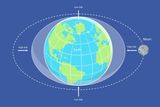Now Reading: Moon Drifting Away from Earth: Tides Play Key Role
-
01
Moon Drifting Away from Earth: Tides Play Key Role
Moon Drifting Away from Earth: Tides Play Key Role

rapid Summary
- The moon is Earth’s sole natural satellite and has been orbiting the planet for approximately 4.5 billion years.
- It influences tides on Earth, holds cultural meaning, and was the first extraterrestrial body humans visited.
- The moon is gradually drifting away from Earth at a rate of about 1.5 inches (3.8 cm) per year, with its current average distance being roughly 239,000 miles (384,400 km).
- Retroreflectors installed during Apollo missions allow scientists to precisely measure this change using lasers in the Lunar laser Ranging (LLR) experiment.
- The distance fluctuates slightly due to the moon’s elliptical orbit but continues to steadily increase because of tidal forces between Earth and the moon.
- Earth’s gravitational pull creates a tidal bulge that lags behind the moon’s position; this interaction pulls the moon forward in its orbit and causes it to move farther away over time.
- While this drift theoretically impacts tides, eclipses, and Earth’s rotational period over millions of years, no significant changes are expected for an extremely long time.
Image Credit: TarikVision/Shutterstock – Diagram illustrating how the moon influences tides on Earth.

Indian Opinion Analysis
The gradual drifting apart of the Earth and its natural satellite presents an intriguing scientific phenomenon with both short-term stability and long-term implications for humanity’s understanding of celestial mechanics. For a country like India-where space exploration is gaining prominence through ISRO-the implications transcend science education into research priorities related to planetary dynamics and human space missions.
India’s Chandrayaan missions signify growing expertise in lunar studies which could contribute valuable insights toward such issues while advancing global scientific collaboration in understanding Earth’s changing relationship with celestial bodies like the Moon. As changes remain largely imperceptible for millions of years, India can continue emphasizing space exploration without immediate concern regarding these effects but should treat them as opportunities for groundbreaking research aligned with global efforts.




























